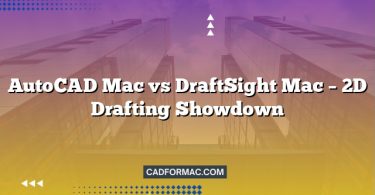External references—commonly known as Xrefs—are a powerful feature in AutoCAD that allow you to reference drawings, images, PDFs, and other file types into your current drawing without embedding the data directly. This non-destructive workflow promotes collaboration, reduces file size, and ensures that updates to referenced files are automatically reflected in your drawing. In AutoCAD for Mac, managing Xrefs is intuitive and closely mirrors the Windows version, with a few platform-specific nuances.
This guide covers the core Xref operations in AutoCAD for Mac: attaching, binding, and reloading external references.
What Are External References?
An external reference is a link to another file that appears in your current drawing as if it were part of it—but remains independent. Changes made to the original file are reflected in your drawing when you reload the reference. Commonly referenced file types include:
.dwg(AutoCAD drawings).dxf(Drawing Interchange Format).pdf(Portable Document Format).jpg,.png,.tif(Raster images).dgn(MicroStation files)
Attaching an External Reference
To attach an external reference in AutoCAD for Mac:
- Open your drawing where you want to insert the reference.
- Go to the Insert tab on the ribbon.
- Click Attach in the Reference panel.
- Alternatively, type
XREFin the command line and press Enter, then choose Attach from the Xref Manager dialog.
- Alternatively, type
- In the Select Reference File dialog:
- Navigate to the file you want to attach.
- Select the file type from the dropdown menu if needed (e.g., DWG, PDF, Image).
- Click Open.
- The Attach External Reference dialog appears:
- Choose Attachment (default) or Overlay:
- Attachment: The Xref is included when the host drawing is referenced into another file.
- Overlay: The Xref is not carried forward if the host drawing becomes an Xref itself—useful to avoid circular references.
- Set the Insertion Point, Scale, and Rotation (you can specify values or check Specify On-Screen to define them interactively).
- Choose Attachment (default) or Overlay:
- Click OK.
- If you selected “Specify On-Screen,” click in the drawing area to place the reference.
Tip: Use the Xref Manager (
XREFcommand) to view, organize, and manage all attached references in one place.
Reloading an External Reference
When the original referenced file is updated (e.g., a colleague modifies a floor plan DWG), you need to reload the Xref to see the changes in your drawing.
To Reload an Xref:
- Open the Xref Manager by typing
XREFand pressing Enter. - In the list of references, locate the file you want to update.
- Right-click the reference and choose Reload.
- Alternatively, select the reference and click the Reload button at the top of the Xref Manager.
AutoCAD for Mac will automatically detect if the referenced file has changed and may prompt you to reload it when you open the drawing.
Note: If the original file has been moved or renamed, AutoCAD will show a “Not Found” status. Use the Find File option in the Xref Manager to locate the new path.
Binding an External Reference
Binding converts an external reference into a permanent part of your drawing. Once bound, the Xref is no longer linked—it becomes native geometry in your file. Use binding when you no longer need the dynamic link (e.g., for final deliverables or archiving).
To Bind an Xref:
- Open the Xref Manager (
XREFcommand). - Select the reference you want to bind.
- Right-click and choose Bind.
- In the Bind Xrefs dialog, choose one of two options:
- Bind: Inserts the Xref content using the original layer names (e.g.,
XREF|WALLbecomesXREF$0$WALL). - Insert: Merges layers and definitions directly into your drawing (e.g.,
XREF|WALLbecomes justWALL), which may cause naming conflicts if layers already exist.
- Bind: Inserts the Xref content using the original layer names (e.g.,
Caution: Binding increases your file size and breaks the live connection to the source file. Use it only when necessary.
Managing Xrefs Efficiently
- Path Types: AutoCAD for Mac supports Full, Relative, and No Path options. Use Relative Path when sharing projects to maintain links across different computers.
- Clipping: You can clip Xrefs to display only a portion using the XCLIP command.
- Fade & Display: Adjust Xref display settings via the Options dialog (AutoCAD menu > Preferences > Display) to control fading and contrast.
Troubleshooting Common Issues
| Issue | Solution |
|---|---|
| Xref shows “Not Found” | Use Find File in Xref Manager to re-link to the correct location. |
| Xref won’t reload | Ensure the source file isn’t open in another instance of AutoCAD or locked by another user. |
| Layers from Xref are missing | Check if the Xref is unloaded—right-click and choose Reload or Load. |
AutoCAD for Windows vs. AutoCAD for Mac: External References (Xrefs) Feature Comparison
| Feature / Functionality | AutoCAD for Windows | AutoCAD for Mac |
|---|---|---|
| Attach Xrefs | ✅ Full support via XREF command, ribbon, and DesignCenter |
✅ Full support via XREF command and Insert tab |
| Xref Manager Dialog | ✅ Dedicated palette with tree view, icons, and context menu | ✅ Modal dialog (not a palette); slightly simplified UI |
| Overlay vs. Attachment | ✅ Both options available | ✅ Both options available |
| Reload Xrefs | ✅ Right-click > Reload; automatic reload prompts | ✅ Right-click > Reload in Xref Manager |
| Bind Xrefs | ✅ Bind or Insert options with layer handling control | ✅ Bind or Insert options available |
| Path Types (Full, Relative, No Path) | ✅ Fully supported | ✅ Fully supported |
Xref Clipping (XCLIP) |
✅ Supported with polyline or rectangle boundary | ✅ Supported (limited to rectangular clipping only) |
| Automatic Reload on Open | ✅ Yes (with notification if file changed) | ✅ Yes |
| Nested Xrefs | ✅ Full support | ✅ Supported, but navigation in Xref Manager is less visual |
Reference Editing (REFEDIT) |
✅ Full in-place editing | ❌ Not available in AutoCAD for Mac |
| Drag-and-Drop from Explorer/Finder | ✅ Supported (Windows Explorer → drawing) | ⚠️ Limited (dragging from Finder may insert as block, not Xref) |
| PDF Underlay as Xref | ✅ Supported | ✅ Supported |
| Image Attach (JPG, PNG, etc.) | ✅ Via IMAGEATTACH or Xref dialog |
✅ Supported |
| Layer Property Control from Xref | ✅ Full control via Layer Properties Manager | ✅ Available, but fewer right-click options in layer list |
| Unload/Reload Individual Xrefs | ✅ Yes | ✅ Yes |
| Xref Fade Control | ✅ Adjustable in Options > Display | ✅ Adjustable in Preferences > Display |
Key Notes:
- AutoCAD for Mac lacks
REFEDIT, a significant limitation for editing referenced content in place.- The Xref Manager on Mac is a modal dialog (not a dockable palette), which can interrupt workflow.
- Clipping on Mac only supports rectangular boundaries—no polyline clipping.
- Overall Xref functionality is robust on both platforms, but Windows offers more advanced tools and UI flexibility.
Frequently Asked Questions (FAQ)
Can I attach a DWG file created in AutoCAD for Windows as an Xref in AutoCAD for Mac?
Yes, absolutely. AutoCAD drawing files (.dwg) are fully compatible between Windows and Mac versions. You can attach a DWG created on Windows as an external reference in AutoCAD for Mac without any conversion. Just ensure both files use a compatible DWG format version (e.g., AutoCAD 2018 or newer).
Why doesn’t AutoCAD for Mac have the REFEDIT command for Xrefs?
AutoCAD for Mac has historically had a more limited feature set compared to the Windows version due to differences in underlying architecture and development priorities. As of 2024, REFEDIT (in-place reference editing) is still not available on Mac. To edit referenced content, you must open the original source file separately and make changes there, then reload the Xref.
What happens if I move the Xref file to a different folder after attaching it?
If you move or rename the referenced file, AutoCAD for Mac will mark it as “Not Found” in the Xref Manager. To fix this, right-click the missing reference in the Xref Manager and choose Find File, then navigate to its new location. Using Relative Paths (set in the Attach dialog or Xref Manager) helps avoid this issue when sharing projects.
Can I attach multiple files at once as Xrefs in AutoCAD for Mac?
No, AutoCAD for Mac does not support multi-select attachment in the Attach External Reference dialog. You must attach each file individually. This differs from some Windows workflows where multiple DWGs can be selected simultaneously in the file browser.
Do Xrefs affect the performance of my drawing on Mac?
Generally, no—Xrefs are designed to improve performance by keeping file sizes small. However, if you attach very large or numerous Xrefs (especially high-resolution images or complex PDFs), you may notice slower panning, zooming, or regeneration. Use Unload (via Xref Manager) to temporarily disable unused references and improve responsiveness.
Is it possible to password-protect an Xref in AutoCAD for Mac?
AutoCAD does not support password protection for Xrefs. If the source DWG is password-protected, AutoCAD for Mac will prompt for the password when loading or reloading the reference. However, once attached, the content is visible to anyone who opens your host drawing—so Xrefs are not a security feature.
Can I use Xrefs with AutoCAD LT for Mac?
No. AutoCAD LT for Mac does not support external references (Xrefs). This is a key limitation of the LT version on both Windows and Mac. You’ll need the full version of AutoCAD for Mac to attach, reload, or bind Xrefs.
Conclusion
Mastering external references in AutoCAD for Mac streamlines collaboration and keeps your projects modular and efficient. By understanding how to attach, reload, and bind Xrefs, you maintain control over your drawing’s dependencies while ensuring accuracy and performance. Whether you’re coordinating with architects, engineers, or clients, Xrefs are indispensable for professional CAD workflows.
For more advanced techniques—such as nesting Xrefs or using reference editing (REFEDIT)—explore AutoCAD’s built-in Help (Help > AutoCAD Help) or Autodesk Knowledge Network.




